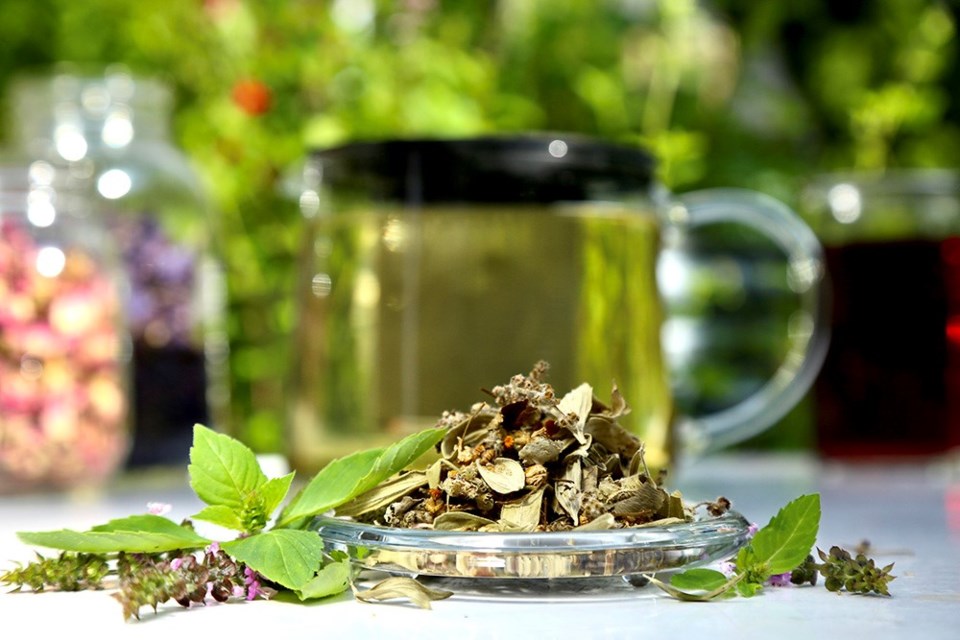After slumbering patiently on the sidelines, waiting for North Americans to recognize her ordained position at the centre of the Ayurvedic adaptogenic medicine wheel, delicious and nutritious holy basil is edging into the spotlight.
Holy basil (Ocimum tenuiflorum), or tulsi (Hindi) isn’t your garden-variety pesto basil, rather a highly valued aromatic perennial native to India, the birthplace of Ayurvedic medicine.
Holy basil is to my palette and olfactory senses, otherwordly delicious. Describing its essence is difficult, but if you imagine a warm pineapply, pink peppercorn and mint crème brulée with licorice, cloves and lemon, you begin to get a sense of it. I can follow my nose to a single specimen mere moments after arriving to a herb garden.
Not two years ago, I was growing holy basil from seed out of necessity. In spite of hours scouring popular nurseries, I could not find a single holy basil plant among the many popular and by comparison fragile varieties that wilt and disintegrate more-or-less on impact with sodden soils and cool weather.
Thankfully, due I assume to an aging (boomers) and enlightened (millennials) consumer population, holy basil now commands pride of place in local nurseries, and gardeners are waking up to its sturdy countenance and myriad attributes.
In natural and plant medicine circles, holy basil is revered as the Mother Medicine of Nature, the Queen of Herbs, and the Elixir of Life.
Emerging science reinforces ancient wisdom about using holy basil as an adaptogen to help humans respond to the physical and mental ill affects of stress, anxiety, fatigue and environment, and bring the body back into so-called balance.
That’s a tall order, and difficult to understand in the context of contemporary medicine. I believe that if we incorporate herbal pharmaceuticals in moderation, into our gardens and our lives, and layer their wholesome and healing goodness into an organic, whole foods diet, we will look, feel and behave much better. I know that I do.
Numerous peer-reviewed studies in journals of Ayurveda and integrative medicines cite examples of applying ancient wisdom and high value natural pharmaceuticals like holy basil to sooth and resolve chronic lifestyle-related diseases of modern life.
Holy basil is widely considered by natural medicine practitioners and advocates, to be a potent culinary and herbal medicine boasting a unique combination of beneficial actions ranging from antioxidant to immunomodulation, that help the whole body manage a plethora of chemical, physical, infectious and emotional stressors, and restore physiological and psychological function.
My No. 1 favourite way to enjoy holy basil is in a simple but complex tea, alone or together with homegrown chamomile and mountain mint, shiso or lemon balm — fresh or dried. Sometimes I add organic honey, and sometimes a splash of lemon or basil vinegar. Hot or cold, this elixir nourishes my body and mind in ways too numerous to list.
Each year, we make mixed herb and holy basil pesto for freezing, using inexpensive local walnuts instead of costly imported pinenuts. I will chiffonade leaves into and overtop of Thai curries, soups and stir fries.
A helpful tip for encouraging every last drop of goodness from fresh leaves it to chop them before steeping – manyfold multiplying the exposed surface area and deepening brew colour. Be sure to add spent leaves to the compost pile, where microbes can imbibe and help spread love through the garden.
I purchased an inexpensive glass teapot with a deep and wide tea infuser from that Swedish store, and it is by far my favourite tool for decocting holy basil and other herbal goodness. Adding dried pink rose petals, purple crocus blossoms, and red hibiscus blossoms (from Persian markets) builds layers of goodness into a jewel-toned punch.
Making beautiful and nourishing holy basil vinegar from pinched blooms now, for holiday gifting is fun and costs little. Using that same vinegar to pickle pears or beets during fall preserving season, infuses winter meals with pink summer sunshine.
Growing holy basil is easy and especially suited to containers and small spaces. I grow holy basil in troughs, together with tomatoes and sage, under the eaves of the house. The plants, bees and butterflies bask in warm sun, protected from torrential rain. Pinch blossoms to encourage side-shooting.
Always check with your health-care provider before changing your diet or incorporating natural medicines.
Laura Marie Neubert is a West Vancouver-based urban permaculture designer. Follow her on Instagram @upfrontandbeautiful, learn more about permaculture by visiting her Upfront & Beautiful website or email your questions to her here.
For a taste of permaculture, click on the YouTube link below:
(Video - Courtesy of West Vancouver Memorial Library)


